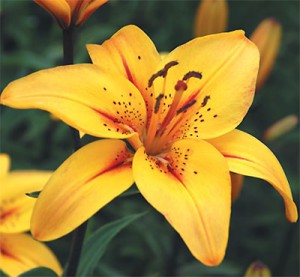Contributing Writers for Wake Up World
Lilium spp. or commonly known as lily, can be described as a hairless perennial herb with single, erect stems from whitish, scaly bulbs. Many of these species are native to Canada, and can be found mainly in cultivated gardens and sometimes along wet roadsides and railroads. The flowers are quite showy, usually dark-dotted in the throat, appearing form May to August. Lilies are seldom plentiful, and when they are picked or mowed, the plant dies. Digging, mowing, and over-picking have caused the near extinction of these beautiful wildflowers in many populated areas. The different variety of lilies include the Canadian lily, the Tiger lily or Columbia lily, and the Wood lily, each ranging in different sizes and colours. The Canadian lily is by far the most common of the three species.
[pro_ad_display_adzone id=”110028″]
Food
The flowers, seeds and bulbs have all been used as food. In particular, the bulbs were the primarily element used by Native American Peoples. They were generally cooked and eaten with other foods, such as venison and fish. Furthermore, The bulbs which have a strong bitter, peppery flavour, have also been used as flavouring and thickening agents for stews. Some tribes also ate lily bulbs fresh or dried them for winter storage. Historically, lily bulbs were boiled in 2 changes of water or steamed in fire pits. Cooked bulbs were dried for winter use, where they were mashed and formed into thin cakes. The flowers have also been used in salads – they are not only delicious, but also bring lots of colour to your dish.
Medicine
Native Peoples used wood lily roots to make medicinal teas that were taken to treat stomach disorders, coughs, tuberculosis, fevers, and help women in labour deliver the afterbirth. The same teas were also used as a wash for swellings, bruises, wounds and sores. A concoction of this plant combined with sweet viburnum roots was used to treat irregular menstruation. Furthermore, lily roots in combination with blackberry roots, raspberries, and staghorn sumac were used to treat coughs, fevers, and consumption.
Other Uses
Lily bulbs were dried, mashed with stink bugs, powdered and used against witchcraft. A decoction of the roots was taken by a wife as an emetic and used as a wash if her husband was unfaithful.
Article Source
Edible & Medicinal Plants of Canada; MacKinnon, Kershaw, Arnason, Owen, Karst, Hamersley, Chambers.
About the Authors
Jordan & Kyla are passionate about health; together, they have overcome many illnesses through dietary and lifestyle changes, and the art of practicing a positive mindset daily. Kyla is currently studying to become a Registered Holistic Nutritionist and Reiki Master, and Jordan is currently learning about traditional North American medicinal herbs, in hopes of becoming a Certified Herbalist. For more information, please visit the following sites; guidinginstincts.com, Facebook, Twitter, Google+, or Pinterest
[pro_ad_display_adzone id=”110027″]







